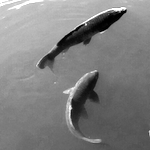Hovering is an important locomotor behavior exhibited by fishes, enabling them to engage in various activities such as foraging, environmental exploration, conspecific interaction, and nest tending. Hovering refers to the ability of a fish to stabilize its position in the water column, with minimal directional movement. The hovering gait in nearly neutrally buoyant fishes is interesting because fishes with a swim bladder are dynamically unstable. These fishes must continuously generate forces to counteract rolling, as their center of mass is positioned above the center of buoyancy. In this comparative study, we selected 14 species of bony fishes to examine the energetic costs and three-dimensional kinematics of fin movement during hovering. Metabolic rates were measured in individual fish during both hovering and resting to assess the net energy expenditure associated with hovering across species. To analyze the kinematics of fins and body during hovering, fishes were filmed using two orthogonal high-speed cameras. The findings reveal that fishes employ diverse motion patterns, engaging multiple propulsors during the hovering gait, and that the metabolic rates during hovering are significantly higher compared to resting. This study demonstrates that fishes experience substantial energetic costs related to body stabilization when they "swim in place."

 PDF version
PDF version
